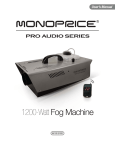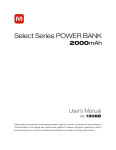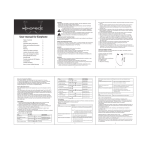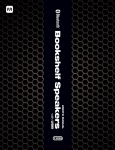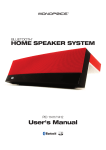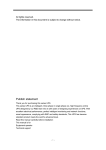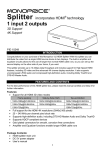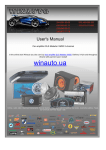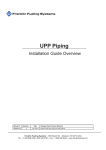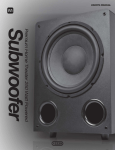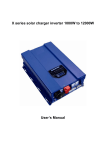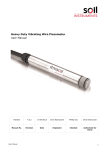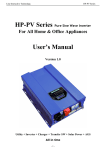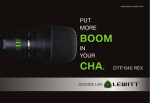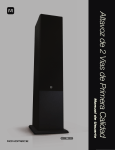Download User`s manual
Transcript
1 SAFETY WARNINGS AND GUIDELINES Please read this entire manual before use, paying extra attention to these safety warnings and guidelines. Please keep this manual in a safe place for future reference. • This device is intended for indoor use only. • Do not expose this device to rain, water, or moisture of any kind. Do not use in extremely dusty environments. • If operating this speaker in a humid environment, ensure that no condensation occurs. Condensation could cause damage to the speaker cone and could cause a short in the subwoofer's amplifier, which in turn could cause fire or severe electric shock. • Do not expose this device to excessively high temperatures. Do not place it in, on, or near heat sources, such as a fireplace, stove, radiator, etc. Do not leave it in direct sunlight. • Clean only using a soft, dry cloth. Do not use chemical cleaners, solvents, or detergents. For stubborn deposits, moisten the cloth with warm water. • Do not use excessive volume when listening to these speakers. If you experience pain, discomfort, or dizziness, reduce volume immediately. Prolonged exposure to excessive volume can cause permanent hearing damage. • Do not stick any objects inside the front port. • Take care not to touch the exposed speaker cones on the front of the unit. • Do not use full volume until after the speaker has been fully broken-in. • If you hear distortion reduce the volume until the distortion is no longer audible. Distortion can sound like a buzzing, scratching, or hammering sound. Distortion can damage or destroy the delicate speaker coils • Do not disassemble or attempt to service these speakers. 2 INTRODUCTION Thank you for purchasing these 2-Way Tower Speakers from Monoprice! These speakers are designed to operate as a stand-alone stereo pair or as part of a larger, multichannel audio system. The tower design places the drivers at ear level for a seated listening position, ensuring that the sound is able to fully expand and radiate around the room. FEATURES • Tower design places drivers at ear level • Silk dome tweeter design • Polypropylene mid-bass speaker cones for greater power-handling capacity • Two mid-bass drivers for enhanced mid-bass response CUSTOMER SERVICE The Monoprice Customer Service department is dedicated to ensuring that your ordering, purchasing, and delivery experience is second to none. If you have any problem with your order, please give us an opportunity to make it right. You can contact a Monoprice Customer Service representative through the Live Chat link on our website (www.monoprice.com) during normal business hours (Mon-Fri: 5am-7pm PT, Sat-Sun: 9am-6pm PT) or via email at [email protected] PACKAGE CONTENTS Please take an inventory of the package contents to ensure you have all the items listed below. If anything is missing or damaged, please contact Monoprice Customer Service for a replacement. 2x Tower speakers 8x Carpet spikes 2x Speaker base 8x Base mounting screws 1x User's manual 3 SPEAKER BREAK-IN In the same way that a new car requires a break-in period before it can be safely operated at high engine RPMs, speakers require a break-in period before they can be safely operated at maximum volume levels. Proper break-in ensures that the moving parts of the speaker (the cone and cone suspension) are allowed to flex and soften, losing their initial stiffness and allowing the speaker to move through its full intended range. After the break-in period, the speakers will produce richer and fatter sounding lows, warmer and smoother sounding mids, and cleaner and more accurate highs, without any hint of distortion. The best way to break-in speakers is simply to play normal music or watch movies at moderate volume levels. The amount of time required for speaker break-in varies based on the operating environment, but is typically in the area of 50~80 hours. It will take a bit longer in a cold or dry environment and a little less time in a warm or humid environment. Note that the break-in period does not have to be continuous. SPEAKER PLACEMENT Before making any connections, you should examine your listening room and decide where you will place the speakers. Some basic "rules of thumb" for the proper placement of a 2-channel speaker system are: • The left and right speakers should be the same distance from their respective side walls. • The left and right speakers should be the same distance from the center of your video screen. • The distance between the left and right speakers should be about 2/3 the distance from the speakers to your listening area. For example, if you sit about 12 feet from the wall on which the speakers are mounted, the left and right speakers should be about 8 feet apart. • The minimum distance between the left and right speakers is about 6 feet. • In order to reduce reflections from the side walls and to ensure you are in the center of the sound cone emitted from the speakers, they should be angled about 30° to point to the center of your listening location. 4 SPEAKER CONNECTIONS Warning! To prevent possible personal injury and/or damage to your equipment, turn off and unplug all equipment before making connections! Preparation Before attempting to make any connections it is best to look at the situation, get all the necessary material together, and then make all the connections at once. First, look at the back of your amplifier or receiver to determine what options it offers for making connections. Amplifiers and receivers typically employ either 5-way binding posts, spring-loaded terminals, or a combination of both for the speaker connections. These speakers feature 5-way binding posts. A 5-way binding post can accept bare speaker wire, spade plugs, pin plugs, and banana plugs, while spring loaded terminals can accept either bare speaker wire or pin plugs. Refer to the documentation that came with your amplifier or receiver to determine the maximum size/gauge speaker wire the speaker terminals can accept. The 5-way binding posts on the speakers can accept thicknesses wire up to 5AWG (5mm diameter). While all options work with bare speaker wire, making bare speaker wire connections is less than ideal. Using banana or pin plugs is highly recommended for several reasons. Plugs are easier to connect, they don't run the risk of stray wire strands shorting the connections, they allow for use of heavier gauge speaker wire in most cases, and it is much easier to identify the polarity from a color coded ring on a plug than from a subtle marking along the length of a wire. Regardless of how you choose to make the connection you will need some speaker wire. The thickness, or gauge, of the wire needed depends on the distance over which the signal will be sent. The following table serves as a guideline for determining the minimum wire gauge to use: Distance (feet) 8 ohms 4 ohms 18 AWG 10 5 16 AWG 20 10 14 AWG 35 18 12 AWG 60 30 10 AWG 100 50 In general you should use the heaviest gauge speaker wire that will fit in the connectors (remember, the smaller the AWG number, the heavier/thicker the wire).Using banana or 5 pin plugs can allow for a heavier gauge wire than most binding posts or terminals will accept. Rather than using fixed length speaker wires, it is best to get a roll and cut the wires to the length you will need them. This ensures that there is a minimum amount of excess wire. However, even if your amplifier is off-center, the lengths of wire used for each speaker pair (front mains or surrounds) should be identical. This keeps the impedance on each channel the same, which ensures that the volume levels, frequency ranges, and tonalities are identical. Any excess wire should be snaked back and forth, but not coiled, to avoid creating an inductor/antenna for stray radio signals. Before making the actual connections, cut each length of wire to size. Note the markings on the wire that differentiate between each conductor. Sometimes the marking clearly identifies a positive and negative side. Some common clearly positive and negative markings or identifiers are: Positive Negative Red Black Copper Silver +++ --- In many cases, the mark is a single stripe on the jacket of one of the connectors. In this case the side with the stripe is generally considered the positive side, but it really does not matter as long as you are consistent in always using the stripe as positive or always using it as negative. If you plan to use banana and/or pin plugs (highly recommended) install the plugs on the wire, taking care to match the polarity of the plug (usually identified by a red or black stripe around the plug body) with the polarity of the wire. Once you have constructed each wire assembly, double check each end to ensure the polarity matches that of the other end on the same conductor. Connecting If you will be using bare wire for any of the connections, strip about 3/8" insulation from the wire end and twist it to prevent stray strands. Although the order in which speakers are connected does not matter, it is easier to keep track of things if you connect speakers one at a time. For each speaker, perform the following: 1. Connect the black/negative side of the wire to the black/negative 5-way binding post on the back of the speaker. Pull gently on the wire to ensure that the connection is mechanically sound. 6 2. Connect the red/positive side of the wire to the red/positive 5-way binding post on the back of the speaker. Pull gently on the final connection to ensure that it is mechanically sound. 3. Connect the black/negative side of the wire to the black/negative connection on the back of the amplifier/receiver. 4. Connect the red/positive side of the wire to the red/positive connection on the back of the amplifier/receiver. 5. Visually inspect the connections on the speaker to ensure that the positive and negative polarities are properly connected. If using bare speaker wire, inspect to ensure that no stray wire strands are present. 6. Visually inspect the connections on the back of the amplifier for proper polarity and the absence of stray wire strands. Repeat steps 1-6 for the other speaker. TROUBLESHOOTING Q1: There is no sound coming from one or both speakers. A1: Verify that the speaker cable connections are properly made and that they are securely attached to both the speaker and amplifier/receiver. Verify that the amplifier is turned on and the volume is not at the minimum level. Check the amplifier to verify that the speakers are not disabled. Ensure that there is nothing plugged into the headphone jack on the amplifier. Q2: The sound coming from the speakers is weak, thin, tinny, or otherwise is not correct. A2: Verify that the speaker polarity matches the polarity on the amplifier. Check to ensure that the speaker wires are securely attached to the speakers and amplifier. TECHNICAL SUPPORT Monoprice is pleased to provide free, live, online technical support to assist you with any questions you may have about installation, setup, troubleshooting, or product recommendations. If you ever need assistance with your new product, please come online to talk to one of our friendly and knowledgeable Tech Support Associates. Technical support is available through the online chat button on our website (www.monoprice.com) during regular business hours, 7 days a week. You can also get assistance through email by sending a message to [email protected] 7 SPECIFICATIONS Model 12209 12210 Speaker Type 2-way full range-bass reflex 2-way full range-bass reflex Tweeter Driver 1" silk dome 1" silk dome Mid-Low Range Driver 2x 5.25" polypropylene with rubber surround and Kapton voice coil former 2x 6.5" polypropylene with rubber surround and Kapton voice coil former Frequency Range 65Hz ~ 20 kHz (±3dB) 55Hz ~ 20 kHz (±3dB) Nominal Input Power 85 watts 100 watts Maximum Input Power 170 watts 200 watts Recommended Amplifier Power 20 ~ 170 watts 20 ~ 200 watts Sensitivity 88dB (2.83V/1m) 90dB (2.83V/1m) Impedance 8 ohms nominal 8 ohms nominal Connectors 5 way binding post terminals 5 way binding post terminals Dimensions (HxWxD) without base 36.3" x 7.8" x 10.0" 37.8" x 8.3" x 11.4" Base Dimensions (HxWxD) 0.8" x 10.0" x 11.9" 0.8" x 10.8" x 13.3" Weight 35.1 lbs. 43.4 lbs. REGULATORY COMPLIANCE This symbol on the product or on its packaging indicates that the product must not be disposed of with normal household waste. Instead, it is your responsibility to dispose of your waste equipment by arranging to return it to a designated collection point for the recycling of waste electrical and electronic equipment. By separating and recycling your waste equipment at the time of disposal, you will help to conserve natural resources and ensure that the equipment is recycled in a manner that products human health and the environment. 8








